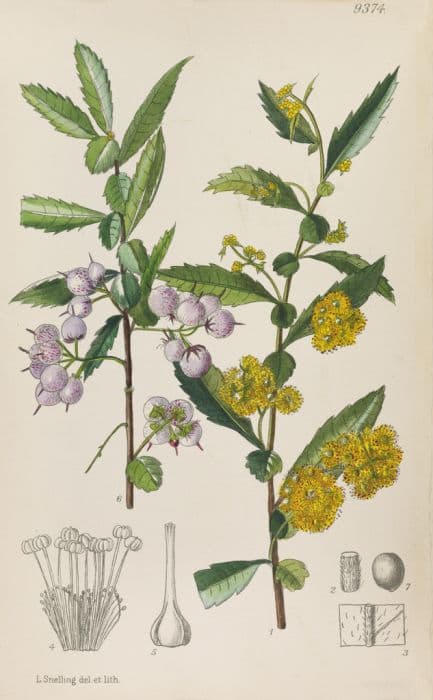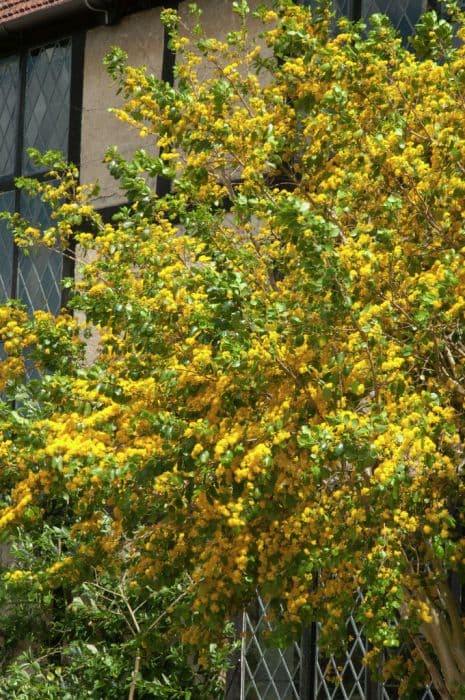White poplar Populus alba

ABOUT
Populus alba, commonly known as the white poplar, has a distinct appearance characterized by its unique leaves and overall form. The leaves exhibit a unique contrast, with dark green tops and white, nearly silver-hued undersides that make the tree particularly striking when leaves flutter in the wind. They are also notable for their deeply lobed shape, somewhat reminiscent of a maple leaf form, with rounded teeth on their edges. Beyond the distinctive foliage, the white poplar bears a bark that is, true to its name, whitish in color, which can make it stand out among other trees. As it matures, the bark often develops blackish diamond-shaped marks, which add to the visual interest of the trunk. The tree's branching pattern typically gives it a broad, spreading canopy that provides ample shade below. When it comes to seasonal changes, the white poplar is deciduous, meaning it will shed its leaves in the fall. Before they fall, the leaves may turn colors, adding seasonal interest to its appearance. In the spring, the tree may produce flowers, although they are typically not the primary feature that draws attention to this species. In summary, the white poplar is admired for its distinctive leaves of contrasting colors, wide-spreading canopy, and uniquely marked, light-colored bark, coming together to create an attractive and often memorable presence in the landscape.
About this plant
 Names
NamesFamily
Salicaceae.
Synonyms
White Poplar, Silver Poplar, Silverleaf Poplar, Abele.
Common names
Populus alba var. pyramidalis Bunge, Populus alba subsp. pyramidalis (Bunge) W.W.Sm., Populus argentea Moench, Populus canescens (Aiton) Sm., Populus nivea Juss., Populus papyrifera Pall., Populus pyramidalis Rozier, Populus rotundifolia Moench, Populus serotina Hartig.
 Toxicity
ToxicityTo humans
Populus alba, commonly known as the white poplar, is not generally considered toxic to humans. There is little documented evidence indicating that ingestion of parts of this tree, such as leaves or bark, leads to severe poisoning in humans. However, as with many plants, individual sensitivities can vary, and it's advisable to refrain from ingesting parts of ornamental or wild plants due to the potential for mild stomach upset or allergic reactions.
To pets
White poplar is not well-documented as a toxic plant to pets either. As with humans, ingestion of parts of the white poplar tree is not generally associated with severe toxicity in animals. Nevertheless, pet owners should exercise caution and prevent pets from ingesting the plant as it may cause mild gastrointestinal discomfort. If a pet shows unusual symptoms after ingestion, it is wise to consult a veterinarian.
 Characteristics
CharacteristicsLife cycle
Perennials
Foliage type
Deciduous
Color of leaves
Green
Height
50 70 [15 21]
Spread
40 60 [12 18]
Plant type
Tree
Hardiness zones
4
Native area
Europe Asia
Benefits
 General Benefits
General Benefits- Shade and Shelter: Populus alba, also known as white poplar, provides significant shade and can act as a windbreak due to its large canopy and dense foliage.
- Erosion Control: The extensive root system of the white poplar helps to stabilize the soil, preventing erosion along riverbanks and in other vulnerable areas.
- Habitat and Food for Wildlife: It supports various wildlife species, offering habitat and food such as leaves and buds for insects and mammals.
- Landscape Enhancement: White poplar is often used in landscaping for its aesthetic appeal, thanks to its distinctive white bark and shimmery leaves.
- Noise Reduction: The dense growth of white poplar trees can help to mitigate noise pollution, making them useful in urban and suburban settings.
- Cooling Effect: The shade provided by white poplar trees can reduce local temperatures, creating cooler microclimates especially during hot weather.
- Cultural and Historical Significance: White poplar often features in history and literature, providing cultural value and educational opportunities.
- Recreational Value: White poplar trees can enhance parks and recreational areas, offering pleasant environments for activities such as walking and picnicking.
- Wood Production: The wood of white poplar is soft and is used for various applications such as in the manufacture of pallets, paper, and plywood.
 Medical Properties
Medical Properties- Anti-inflammatory: Populus alba, commonly known as white poplar, reportedly contains salicin, a compound that may have anti-inflammatory effects.
- Analgesic: The salicin in white poplar may also act as a pain reliever.
- Antiseptic: Extracts from the buds and bark might have antiseptic properties, potentially useful for treating minor wounds or infections.
- Diuretic: Some traditional remedies suggest that parts of the white poplar tree may act as a diuretic, helping to promote the excretion of urine.
- Febrifuge: The white poplar has been historically used to reduce fever; however, modern science might not fully support this application.
- Astringent: Certain compounds in the tree could have astringent properties, which might be useful in toning and tightening the skin or tissues.
 Air-purifying Qualities
Air-purifying QualitiesThis plant is not specifically known for air purifying qualities.
 Other Uses
Other Uses- Livestock feed: Leaves from Populus alba, commonly known as white poplar, can be used as fodder for livestock, providing a supplementary food source for animals like goats and sheep.
- Ornamental use: The white poplar is often used in landscape design and urban plantings for its distinctive white bark and attractive shape.
- Sound barrier: Because of its dense foliage and rapid growth, white poplar can be planted as a natural sound barrier to reduce noise pollution.
- Windbreaks and shelterbelts: White poplar trees are commonly used to create protective barriers against wind erosion on agricultural land.
- Soil stabilization: The root system of white poplar helps stabilize soil and prevent erosion, making it useful in reforestation and environmental restoration projects.
- Tannin extraction: The bark of the white poplar contains tannins that can be extracted and used in the leather tanning industry.
- Agroforestry systems: Populus alba can be incorporated into agroforestry practices for its fast growth and ability to improve soil quality with leaf litter.
- Woodworking and crafts: The wood of white poplar is soft and easy to work with, making it suitable for carving, turnery, and other craftwork.
- Paper production: The fibers of white poplar are used in the manufacture of paper, notably for producing paper pulp.
- Biomass production: White poplar can be cultivated for biomass energy due to its rapid growth rate, contributing to renewable energy resources.
Interesting Facts
 Feng Shui
Feng ShuiThe White Poplar is not used in Feng Shui practice.
 Zodiac Sign Compitability
Zodiac Sign CompitabilityThe White Poplar is not used in astrology practice.
 Plant Symbolism
Plant Symbolism- Peace and Hope: The Populus alba, commonly known as White Poplar, often symbolizes peace and hope as its presence by water sources can evoke a sense of tranquility.
- Resilience and Perseverance: White Poplar trees are known for their ability to thrive in difficult conditions, representing resilience and the ability to overcome challenges.
- Adaptability: Given their tolerance of various soils and climates, White Poplars symbolize adaptability and flexibility in life.
- Victory and Triumph: In some cultures, branches of the White Poplar were awarded to victorious athletes, symbolizing victory and triumph over adversaries.
- Rebirth and Renewal: With their bright white undersides of leaves that appear to flutter and flash in the wind, White Poplars are often associated with rebirth and the renewal of life.
 Water
WaterThe White Poplar should be watered deeply and thoroughly, allowing the water to reach the roots, rather than just wetting the surface. Young trees require more frequent watering, about once a week, with approximately 15-20 gallons during each session. Mature White Poplars are more drought tolerant and may require less frequent watering, depending on the weather conditions and soil moisture levels. During the hot summer months, it's essential to monitor the soil and water the tree every two to three weeks if there hasn't been significant rainfall. The amount of water can be adjusted based on rainfall, with the aim to keep the soil consistently moist but not waterlogged.
 Light
LightWhite Poplars thrive in full sunlight, needing at least six hours of direct, unfiltered sun daily. The best spot for a White Poplar is an open area where it can receive ample sunlight throughout the day without obstruction from taller buildings or other trees. These trees do not perform well in shaded conditions, as inadequate light can hinder their growth and health.
 Temperature
TemperatureWhite Poplars are hardy and can survive in a variety of temperature conditions, with an ideal growth range between 50°F and 75°F. They can withstand a maximum temperature of up around 90°F and a minimum cold threshold in the region of 20°F. While they can tolerate a range of temperatures, prolonged exposure to extremes outside of their hardiness zone can be damaging, so it's important to consider the typical climate of the area when planting.
 Pruning
PruningWhite Poplars should be pruned to remove dead or broken branches, shape the tree, and encourage healthy growth. Pruning is best done in late winter or early spring before the tree's dormant period ends. Annual or biennial pruning is usually sufficient to maintain tree health and structure. The ideal time for major pruning is when the tree is young to establish a strong frame for future growth.
 Cleaning
CleaningNot needed
 Soil
SoilWhite Poplar thrives best in a soil mixture that is well-draining, with a blend of loam, peat, and sand. The ideal soil pH for White Poplar should be between 5.5 and 7.5.
 Repotting
RepottingWhite Poplar, being a fast-growing and large tree, is not typically repotted. Instead, it is transplanted outdoors when young to accommodate its rapid growth.
 Humidity & Misting
Humidity & MistingWhite Poplar is tolerant of a wide range of humidity levels and does not have specific humidity requirements, making it suitable for various outdoor environments.
 Suitable locations
Suitable locationsIndoor
Not suitable for indoor growth due to size.
Outdoor
Plant in well-draining soil, full sun, and water regularly.
Hardiness zone
3-9 USDA
 Life cycle
Life cyclePopulus alba, commonly known as white poplar, begins its lifecycle with seed dispersal, which is typically aided by wind given its lightweight and fluffy seeds. Upon landing in suitable soil, the seeds germinate and the plant enters the seedling stage, establishing roots, a stem, and the first few leaves to start photosynthesis. As it grows, the white poplar enters the sapling stage, continuously developing a more robust root system, a thicker trunk, and a fuller canopy. Reaching maturity, it produces flowers, which are usually dioecious, meaning male and female flowers are on separate trees; these flowers then pollinate to set seeds. Once pollinated, female trees produce capsules that open to release seeds, continuing the reproductive cycle. The mature white poplar can live for several decades, going through the cycle of reproduction annually, and can also propagate vegetatively via root suckers, creating clones of the parent tree.
 Propogation
PropogationPropogation time
Spring-Early Summer
Populus alba, commonly known as white poplar, can be propagated effectively using hardwood cuttings. The best time for this method is during the dormant season, which typically falls in late winter before the buds begin to swell. To propagate by cuttings, healthy, mature branches from the previous year's growth are selected and cut into segments about 6 to 8 inches (15 to 20 centimeters) in length. Each cutting should have at least a couple of buds. The cuttings are then either inserted directly into the ground where they are to grow or placed in pots with a well-drained rooting medium. The base of each cutting is often dipped in a rooting hormone to encourage root development. Keeping the cuttings in a moist environment is crucial until roots develop and the new plants can be transferred to their permanent locations.









